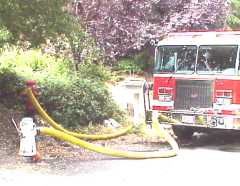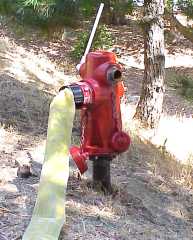© 2000 Capt. Willis Lamm, Water Supply Officer, Moraga-Orinda (CA) Fire DistrictBackground Criteria Storage Distribution Hyd. Design Placement Installation Codes & Markings Applications Codes & Standards
|
| HYDRANT DESIGN |
|
Aside from the general purpose of delivering water for fire fighting, the hydrant design
selected must be based on a number of operational elements. Some issues to consider
include:
Generally speaking, water supply systems in residential areas should be designed to deliver no less than 1000 GPM (3785 L/min) at each individual hydrant. In commercial and multi-story apartment zones, this volume should increase based on the required fire flows of the buildings being protected. If the required fire flows are several thousand GPM, the required flow will usually have to be met by two or more hydrants flowing simultaneously.
The operations of the fire department or fire brigade must be taken into
consideration. In instances where new hydrant systems are replacing poor
or nonexistent systems, new fire fighting approaches need to be developed
to make proper use of the new system. Hydrant designs
should capably and easily provide necessary water to fire engines currently
in service as well as more modern fire engines which may be purchased in the
future. For example, a fire brigade may have smaller engines equipped with
medium diameter hose and 750 GPM (2850 L/min) pumps, however with a suitable water supply system,
the brigade may upgrade to engines equipped with large diameter hose and pumps
with a capacity of 1250 GPM (4732 L/min) or greater. Accordingly it may be appropriate to
specify fire hydrants which have medium diameter hose outlets as well as a large diameter
pumper outlet.
|
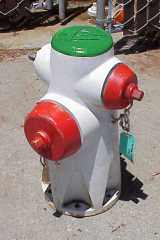
|
|
In the event of a major emergency, fire companies may be requested from multiple jurisdictions. Hydrant outlet threads should meet the regional standard for compatibility among all fire engines, regardless of origin. If no large diameter outlet size and thread has been established, we recommend the 5" Storz configuration.
Hydrants need to be readily recognizable and accessible. Placement and installation considerations
should take into account the shape of the hydrant as well as the positions of valves and outlets.
Specific suggestions regarding hydrant placement are presented later in this feature.
| |
|
Hydrants must be simple and reliable to connect to and to operate. Operating nuts should be
pentagonal or triangular in design to reduce tampering by unauthorized persons. Discharge valves should be
specified to open by turning counter-clockwise and close clockwise. (Underground valves on water mains and
on the hydrant branch line should operate according to local or regional standards.)
Hydrant designs must be appropriate for the amount of head (static pressure) that is applied to them. The minimum working pressure rating of any fire hydrant should be 150 p.s.i. Hydrants installed in higher pressure installations should be rated appropriately. All fire hydrants should be static tested at twice the rated working pressure. |
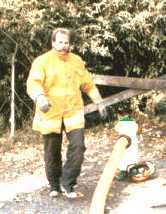
|
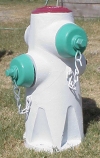
| In temperate climates where hard freezing is not an issue, the most efficient hydrant design is the "wet barrel" hydrant where valves are located above ground and can be independently controlled. In colder climates, dry barrel hydrants will be required which use a single operating valve that is located below ground in the base of the riser and which charge all outlets simultaneously when turned on. |

|
| Continue to Part 5 |
Return to Part 3
Return to Information Section
Return to Water Supply Page
Background Criteria Storage Distribution Hyd. Design Placement Installation Codes & Markings Applications Codes & Standards
|
